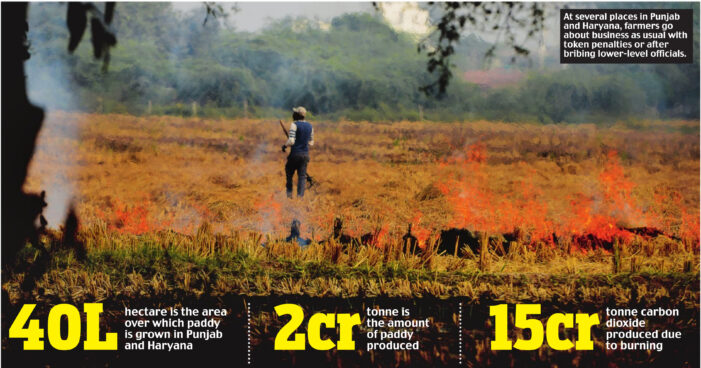Chandigarh : THOUGH chief minister Amarinder Singh’s government claimed recently that crop residue bur-ning in Punjab has come down by a significant 30 per cent, smoke emanating from the ground indicates otherwise. MAIL TODAY visited Punjab and Haryana and found vast swathes of agricultural land on both sides of NH-1 — traversing Sonipat, Panipat, Karnal, Kurukshetra, Ludhiana and further — turned charcoal black. Importantly, farmers informed that after residue from the hybrid PR14 variety of rice was burnt over the last two months, now straw from Basmati rice is going to be set ablaze, which accounts for 30 per cent of the total paddy cultivation. Also, since the weather has cooled down and there is moisture on the crops, there will be more pollution compared to rapid burning of the remnants. Sources reported that in several villages, there was little to no implementation of the National Green Tribunal (NGT) ban and fines for crop burning on farmers. In several places, farmers went about their business as usual or with “token penalties”. Incidents also came to fore where lower level officials pocketed part of the money for not levying the full penalty. Bageesh Kumar, a farmer in Kaithal district of Haryana, said, “Even till a few days back, acres and acres of land were burned. A member of the panchayat here burnt 25 acres, but was penalised for only one acre. Neither police nor the SDM even came to the doorsteps of many such farmers.” This is despite NGT spelling out definitive slabs of fine for crop burning — `2,500 for less than two acres, `5,000 for medium land owners holding over two acres and less than five acres, and `15,000 for those owning more than five acres. “More than 80 per cent farmers here don’t know what’s a happy seeder and government agriculture department scientists only teach us how to use copious amounts of urea and pesticide instead of healthy ways of farming like mixing the straw in the land,” Bageesh added. Joginder Mann, a farmer in Patiala’s Bahawalpur, attributed the lack of action to the reigning Congress government’s unwillingness to offend the farming class. “The Punjabi business community is already seething with anger over GST. Government employees are not being paid regularly as the state does not have enough funds. They certainly don’t want to jeopardise their poll prospects by upsetting farmers too,” he said. MANN said in his village, about 1,800 acres covered by paddy straw were consigned to flames. “Had you come a few days back, you would have seen only fire everywhere. We couldn’t breathe or see. Our skins turned bad due to the blazing heat,” he added. Farmer Harkeerat Singh from the same village said, “There is only one biomass plant here which takes our paddy residue. It, in fact, ends up creating more pollution all the year round by burning it to generate electricity.” Environment activist Vikrant Tongad, who has pursued the issue since 2012, said even NASA images showed ample crop burning in Yamunanagar, Ambala, Panchkula, Amritsar and Jalandhar.


You must be logged in to post a comment Login